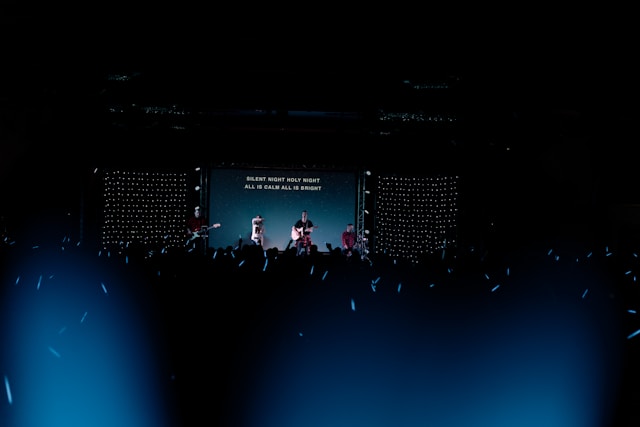The concert experience has always been about connection between artists and fans, between music and emotion, between presence and memory. But as the world grew more digital, especially following the global pandemic, a new form of performance began taking center stage: virtual concerts. Once a novelty, they’ve now become a powerful and increasingly mainstream part of the live music experience.
In this article, we explore how virtual music events are reshaping the entertainment industry, the technology behind them, the benefits and challenges they present, and what the future holds for this innovative form of musical engagement.
What Are Virtual Concerts?
Virtual concerts are live or pre-recorded performances that are streamed or broadcasted over the internet using digital platforms. Unlike traditional concerts, these events allow fans to attend from anywhere in the world using devices like phones, computers, VR headsets, or even gaming consoles.
They range in format from simple Instagram Live acoustic sets to high-production VR concerts inside digital spaces like Fortnite or Meta’s Horizon Worlds. These online concert experiences can also be interactive, allowing fans to chat, send virtual gifts, vote on setlists, or even appear as avatars in virtual arenas.
The Technology Behind Virtual Concerts
The growth of virtual concerts wouldn’t be possible without significant advances in technology. Today’s most compelling online concert experiences are powered by a mix of real-time rendering, motion capture, spatial audio, and streaming tools.
-
Platforms like Twitch, YouTube Live, TikTok Live, and Instagram allow real-time broadcasting to massive audiences.
-
Gaming platforms like Roblox and Fortnite provide immersive spaces where artists can perform as digital avatars, turning concerts into interactive virtual festivals.
-
Virtual reality services like Wave and Meta’s Horizon Worlds offer 360-degree environments where fans can “attend” concerts using VR headsets.
-
Motion capture enables artists to perform in real life while their avatars mimic their movements in a digital space.
-
Blockchain technology is beginning to support NFT-based ticketing and exclusive digital merchandise for virtual music events.
Together, these tools are creating a new genre of entertainment blending performance, gaming, and storytelling.
Benefits of Virtual Concerts
There are several reasons why virtual concerts have gained such popularity, even as physical venues reopen.
1. Accessibility
Virtual concerts remove geographic and financial barriers, allowing fans from all over the world to attend a show without travel or high ticket prices. This opens the door to more inclusive and global fanbases.
2. Creative Freedom
Artists can perform in environments that would be impossible in the real world. Think floating stages, space-age landscapes, or fully animated avatars. It’s a new canvas for artistic expression.
3. Lower Costs
Without the need for physical venues, security, or on-site staff, production costs can be lower, allowing indie artists and emerging acts to host their own events.
4. New Revenue Streams
Through ticket sales, virtual VIP access, donations, NFTs, or selling digital merch, virtual concerts present unique ways for artists to monetize their craft beyond traditional means.
Challenges and Limitations
While virtual concerts bring innovation and reach, they also come with certain drawbacks.
1. Lack of Physical Energy
There’s something irreplaceable about the energy of a live crowd, the bass you feel in your chest, and the spontaneity of an in-person performance. Virtual shows still struggle to recreate this visceral experience.
2. Technical Barriers
Not all fans have access to stable internet connections, VR gear, or platforms hosting the events. Glitches, buffering, and sound sync issues can also disrupt the experience.
3. Monetization Uncertainty
While there are new income opportunities, it’s still unclear how sustainable these are, especially for smaller acts. The novelty factor might wear off if experiences don’t continue to evolve.
Major Examples of Virtual Concerts
Some of the biggest names in music have already embraced this format, proving that virtual concerts can rival—or even exceed—traditional ones in scope and spectacle.
-
Travis Scott’s Fortnite concert in 2020 drew over 12 million live viewers, creating a cinematic experience inside a video game.
-
BTS has hosted multiple virtual shows on Weverse and YouTube, connecting with millions of fans during the pandemic.
-
Ariana Grande’s Fortnite Rift Tour brought surreal visual elements and interactive gameplay to her digital audience.
-
Justin Bieber’s Wave concert featured a fully rendered 3D avatar and allowed fans to interact in real-time during the show.
Meanwhile, platforms like Twitch and Discord have become go-to places for smaller, more intimate virtual music events featuring indie artists and up-and-coming performers.
The Future of Virtual Concerts
As technology continues to evolve, the future of virtual concerts looks promising and increasingly hybrid.
1. Hybrid Events
Combining physical and virtual experiences, hybrid concerts will allow fans to choose how they attend, potentially selling more tickets than ever before while accommodating different preferences.
2. AI and Interactive Performances
AI-driven avatars and set designs may allow artists to create adaptive shows based on audience reactions, song choices, or even real-time fan polls.
3. Immersive Hardware
As AR glasses, haptic suits, and VR headsets become more accessible, fans will be able to experience live streaming concerts in far more immersive and tactile ways.
4. Fan-Controlled Environments
Imagine concerts where the audience controls lighting, camera angles, or even what song gets played next. These innovations are closer than we think.
Conclusion
The rise of virtual concerts is more than a temporary solution to canceled tours it represents a new frontier in how we experience music. As live streaming concerts and virtual music events continue to evolve, they offer both challenges and opportunities for the industry. Far from replacing physical concerts, they’re becoming a powerful complement offering accessibility, creativity, and connection in the digital age.

